JEEP WRANGLER 2010 JK / 3.G Owner's Guide
Manufacturer: JEEP, Model Year: 2010, Model line: WRANGLER, Model: JEEP WRANGLER 2010 JK / 3.GPages: 554, PDF Size: 10.76 MB
Page 31 of 554
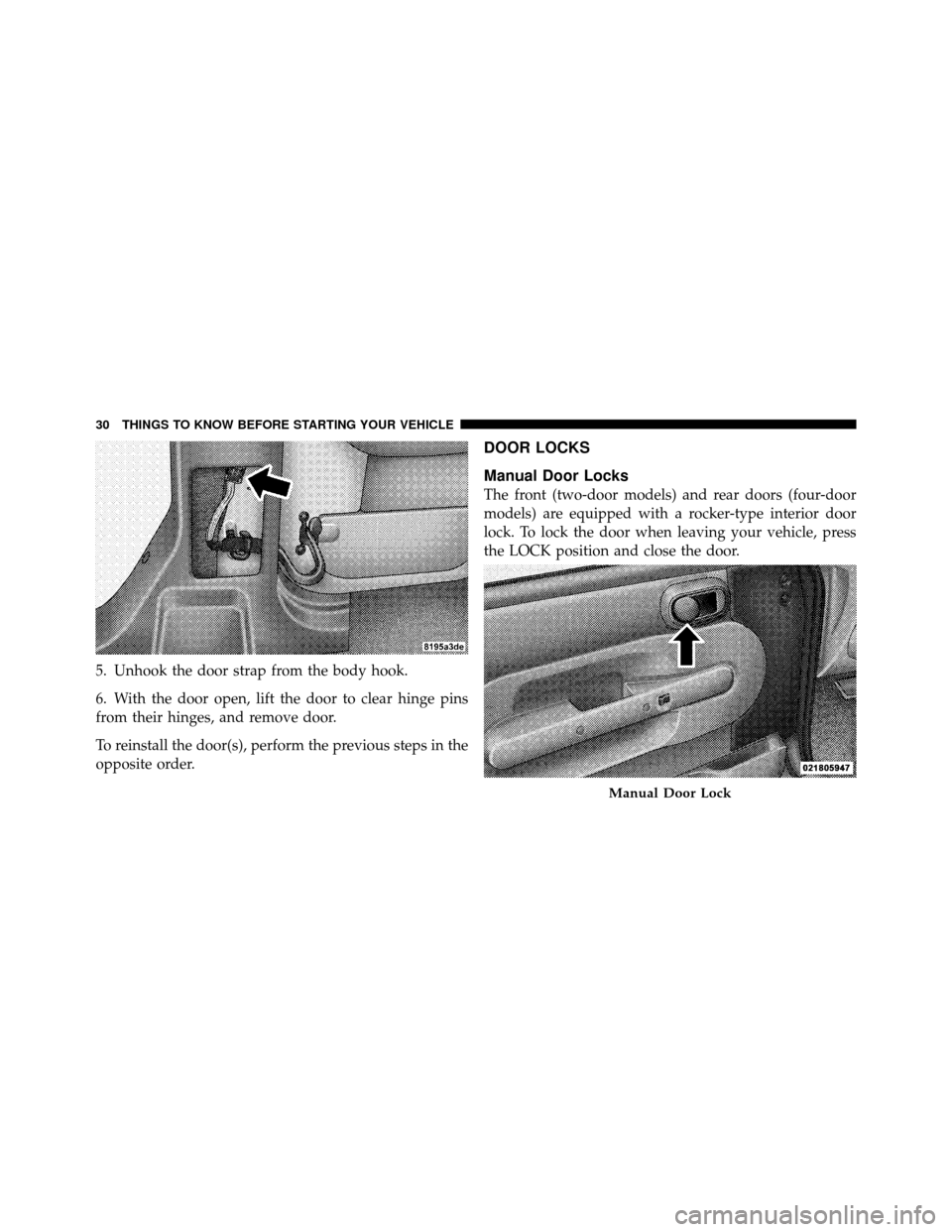
5. Unhook the door strap from the body hook.
6. With the door open, lift the door to clear hinge pins
from their hinges, and remove door.
To reinstall the door(s), perform the previous steps in the
opposite order.
DOOR LOCKS
Manual Door Locks
The front (two-door models) and rear doors (four-door
models) are equipped with a rocker-type interior door
lock. To lock the door when leaving your vehicle, press
the LOCK position and close the door.
Manual Door Lock
30 THINGS TO KNOW BEFORE STARTING YOUR VEHICLE
Page 32 of 554
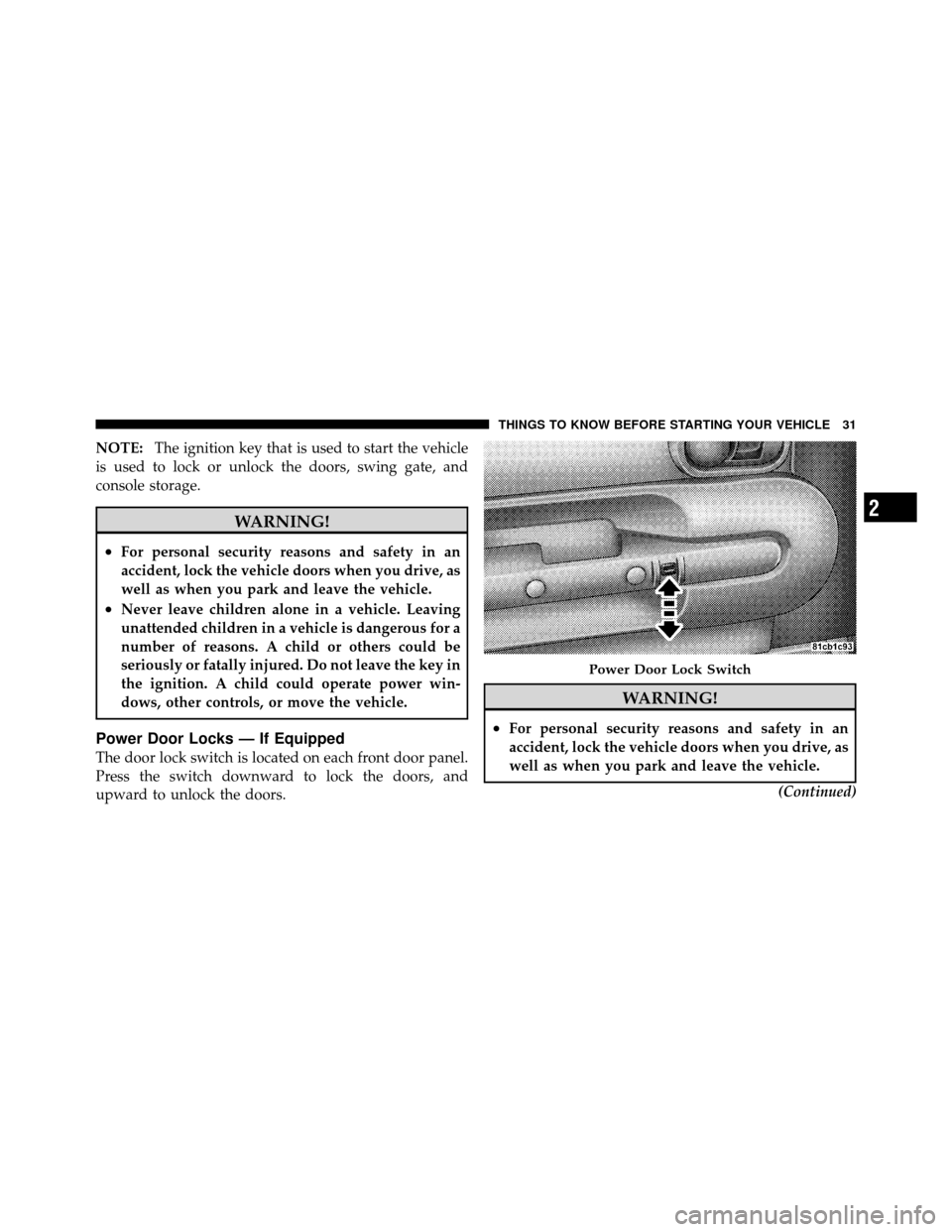
NOTE:The ignition key that is used to start the vehicle
is used to lock or unlock the doors, swing gate, and
console storage.
WARNING!
•For personal security reasons and safety in an
accident, lock the vehicle doors when you drive, as
well as when you park and leave the vehicle.
•Never leave children alone in a vehicle. Leaving
unattended children in a vehicle is dangerous for a
number of reasons. A child or others could be
seriously or fatally injured. Do not leave the key in
the ignition. A child could operate power win-
dows, other controls, or move the vehicle.
Power Door Locks — If Equipped
The door lock switch is located on each front door panel.
Press the switch downward to lock the doors, and
upward to unlock the doors.
WARNING!
•For personal security reasons and safety in an
accident, lock the vehicle doors when you drive, as
well as when you park and leave the vehicle.
(Continued)
Power Door Lock Switch
2
THINGS TO KNOW BEFORE STARTING YOUR VEHICLE 31
Page 33 of 554
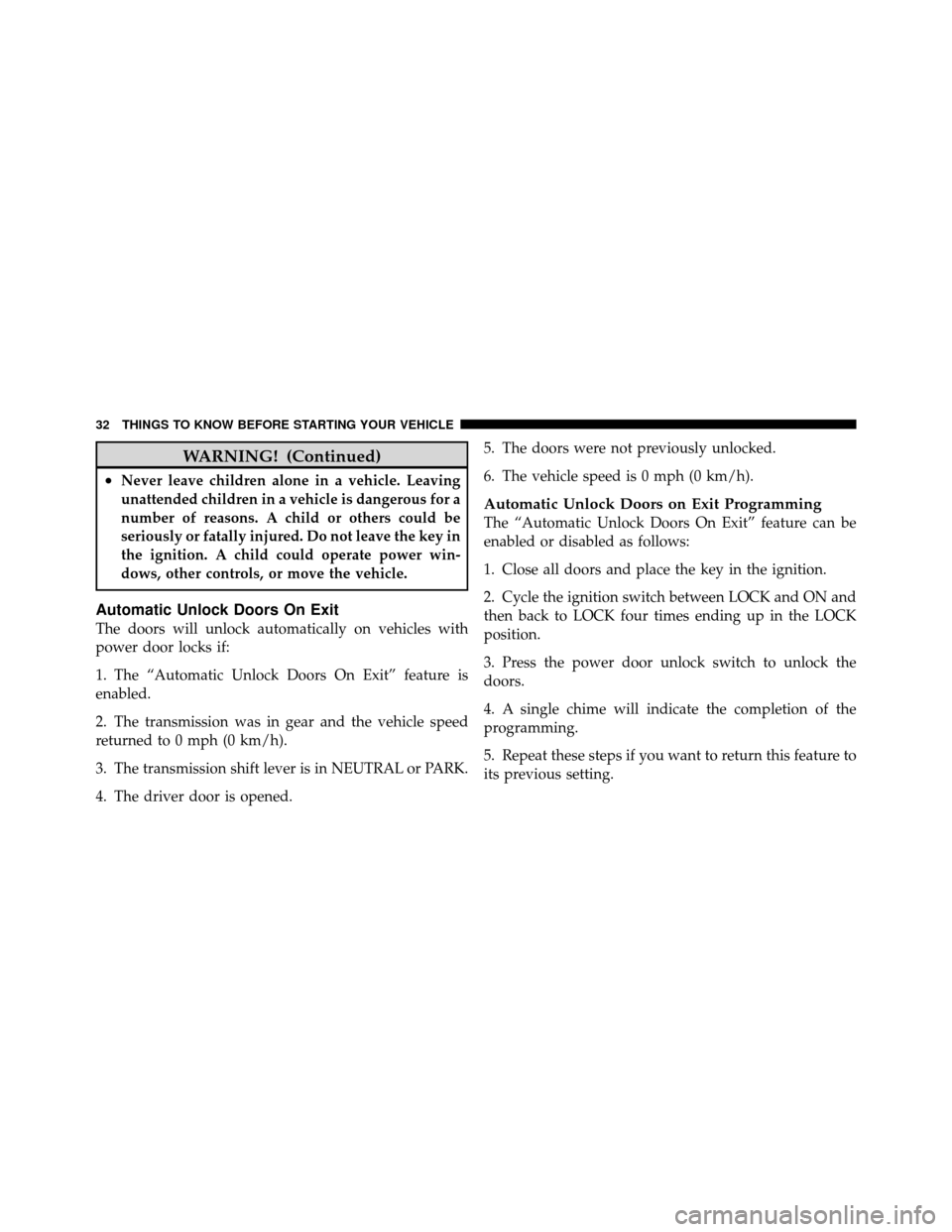
WARNING! (Continued)
•Never leave children alone in a vehicle. Leaving
unattended children in a vehicle is dangerous for a
number of reasons. A child or others could be
seriously or fatally injured. Do not leave the key in
the ignition. A child could operate power win-
dows, other controls, or move the vehicle.
Automatic Unlock Doors On Exit
The doors will unlock automatically on vehicles with
power door locks if:
1. The “Automatic Unlock Doors On Exit” feature is
enabled.
2. The transmission was in gear and the vehicle speed
returned to 0 mph (0 km/h).
3. The transmission shift lever is in NEUTRAL or PARK.
4. The driver door is opened.5. The doors were not previously unlocked.
6. The vehicle speed is 0 mph (0 km/h).
Automatic Unlock Doors on Exit Programming
The “Automatic Unlock Doors On Exit” feature can be
enabled or disabled as follows:
1. Close all doors and place the key in the ignition.
2. Cycle the ignition switch between LOCK and ON and
then back to LOCK four times ending up in the LOCK
position.
3. Press the power door unlock switch to unlock the
doors.
4. A single chime will indicate the completion of the
programming.
5. Repeat these steps if you want to return this feature to
its previous setting.
32 THINGS TO KNOW BEFORE STARTING YOUR VEHICLE
Page 34 of 554
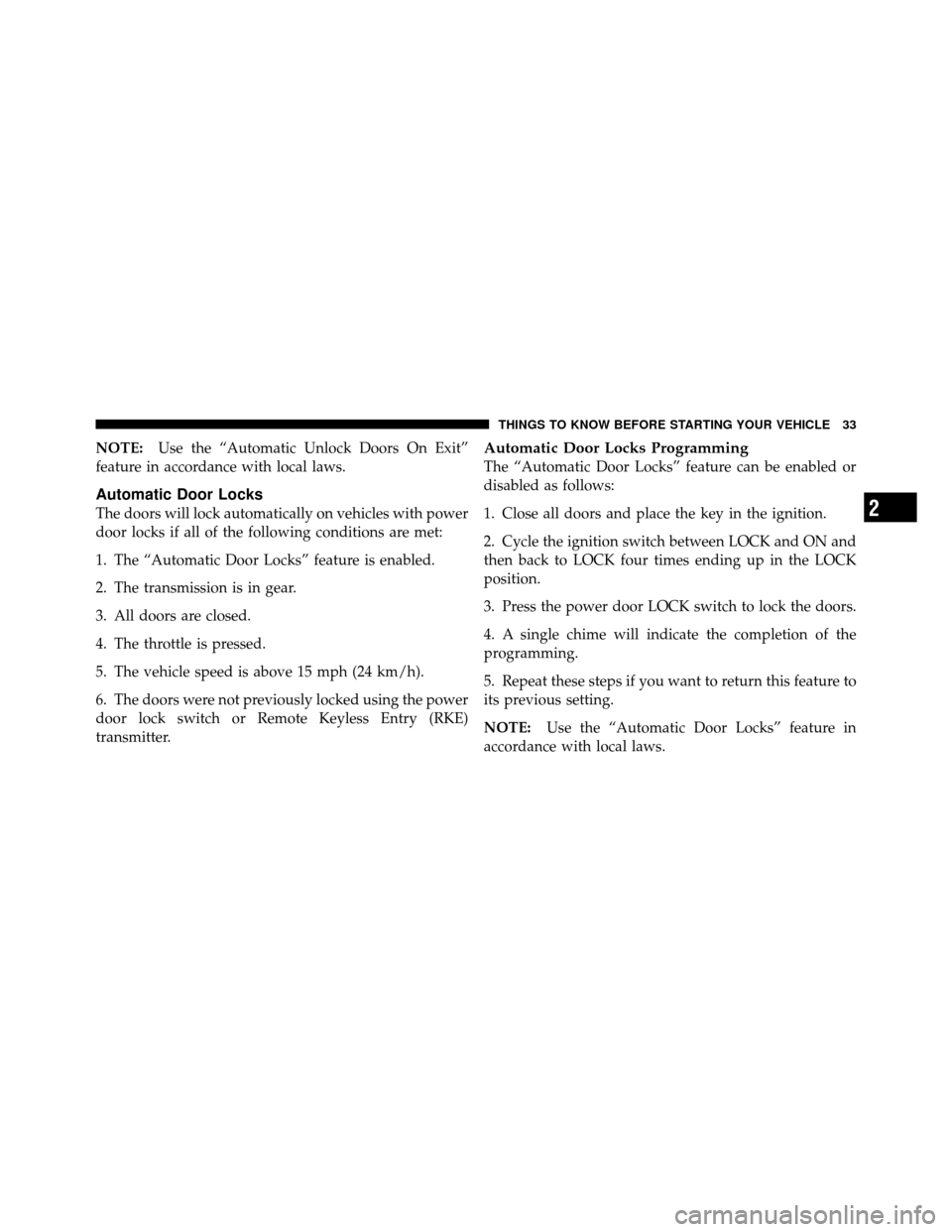
NOTE:Use the “Automatic Unlock Doors On Exit”
feature in accordance with local laws.
Automatic Door Locks
The doors will lock automatically on vehicles with power
door locks if all of the following conditions are met:
1. The “Automatic Door Locks” feature is enabled.
2. The transmission is in gear.
3. All doors are closed.
4. The throttle is pressed.
5. The vehicle speed is above 15 mph (24 km/h).
6. The doors were not previously locked using the power
door lock switch or Remote Keyless Entry (RKE)
transmitter.
Automatic Door Locks Programming
The “Automatic Door Locks” feature can be enabled or
disabled as follows:
1. Close all doors and place the key in the ignition.
2. Cycle the ignition switch between LOCK and ON and
then back to LOCK four times ending up in the LOCK
position.
3. Press the power door LOCK switch to lock the doors.
4. A single chime will indicate the completion of the
programming.
5. Repeat these steps if you want to return this feature to
its previous setting.
NOTE: Use the “Automatic Door Locks” feature in
accordance with local laws.
2
THINGS TO KNOW BEFORE STARTING YOUR VEHICLE 33
Page 35 of 554
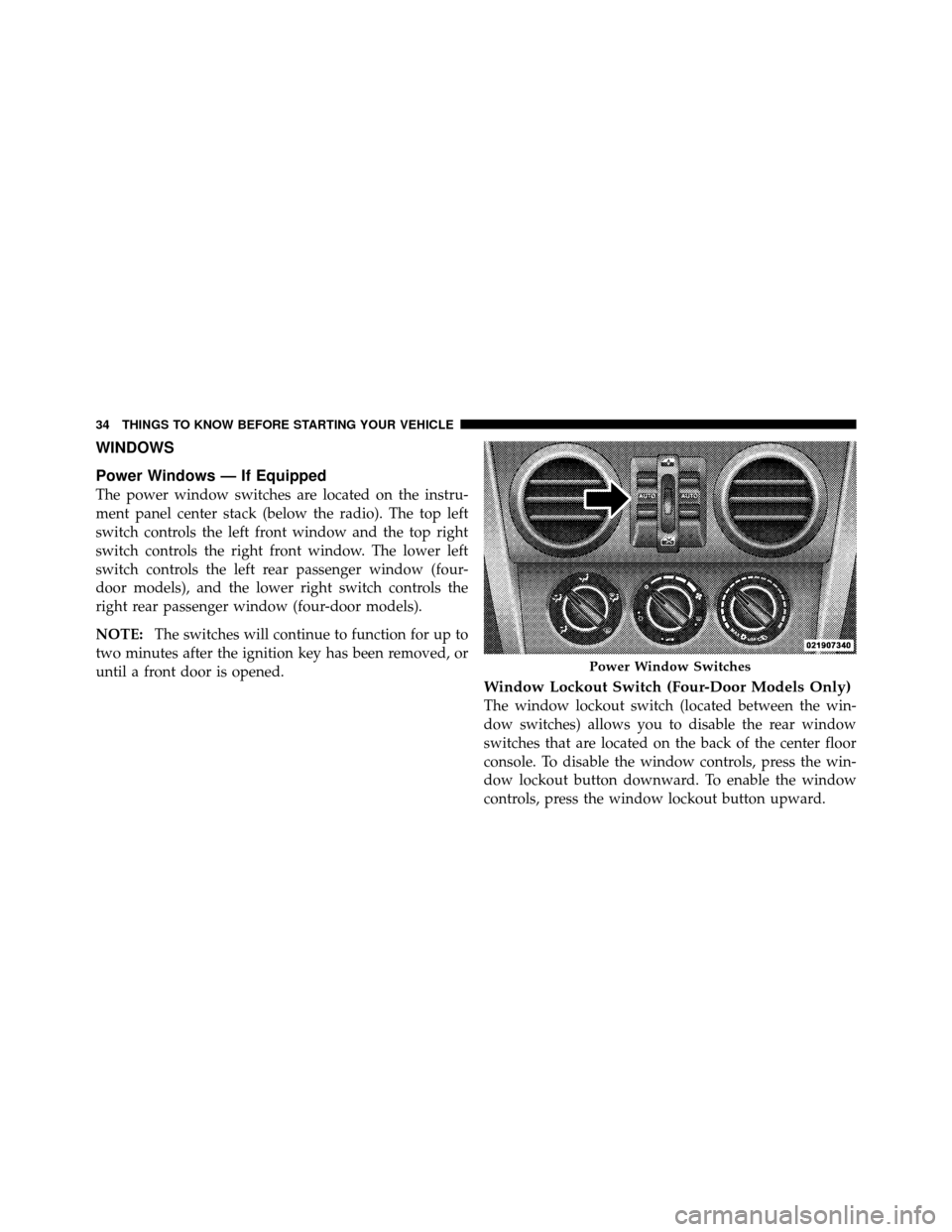
WINDOWS
Power Windows — If Equipped
The power window switches are located on the instru-
ment panel center stack (below the radio). The top left
switch controls the left front window and the top right
switch controls the right front window. The lower left
switch controls the left rear passenger window (four-
door models), and the lower right switch controls the
right rear passenger window (four-door models).
NOTE:The switches will continue to function for up to
two minutes after the ignition key has been removed, or
until a front door is opened.
Window Lockout Switch (Four-Door Models Only)
The window lockout switch (located between the win-
dow switches) allows you to disable the rear window
switches that are located on the back of the center floor
console. To disable the window controls, press the win-
dow lockout button downward. To enable the window
controls, press the window lockout button upward.
Power Window Switches
34 THINGS TO KNOW BEFORE STARTING YOUR VEHICLE
Page 36 of 554
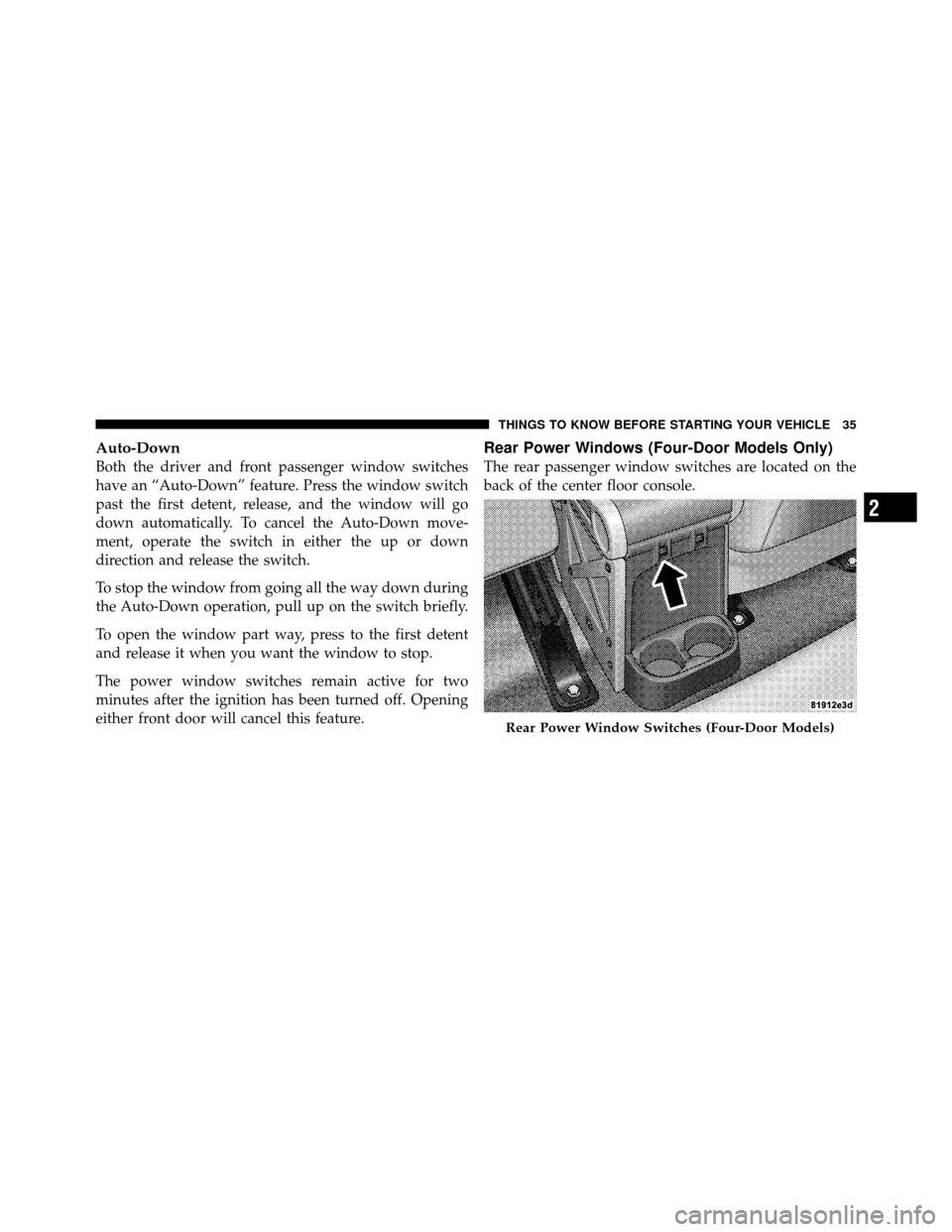
Auto-Down
Both the driver and front passenger window switches
have an “Auto-Down” feature. Press the window switch
past the first detent, release, and the window will go
down automatically. To cancel the Auto-Down move-
ment, operate the switch in either the up or down
direction and release the switch.
To stop the window from going all the way down during
the Auto-Down operation, pull up on the switch briefly.
To open the window part way, press to the first detent
and release it when you want the window to stop.
The power window switches remain active for two
minutes after the ignition has been turned off. Opening
either front door will cancel this feature.
Rear Power Windows (Four-Door Models Only)
The rear passenger window switches are located on the
back of the center floor console.
Rear Power Window Switches (Four-Door Models)
2
THINGS TO KNOW BEFORE STARTING YOUR VEHICLE 35
Page 37 of 554
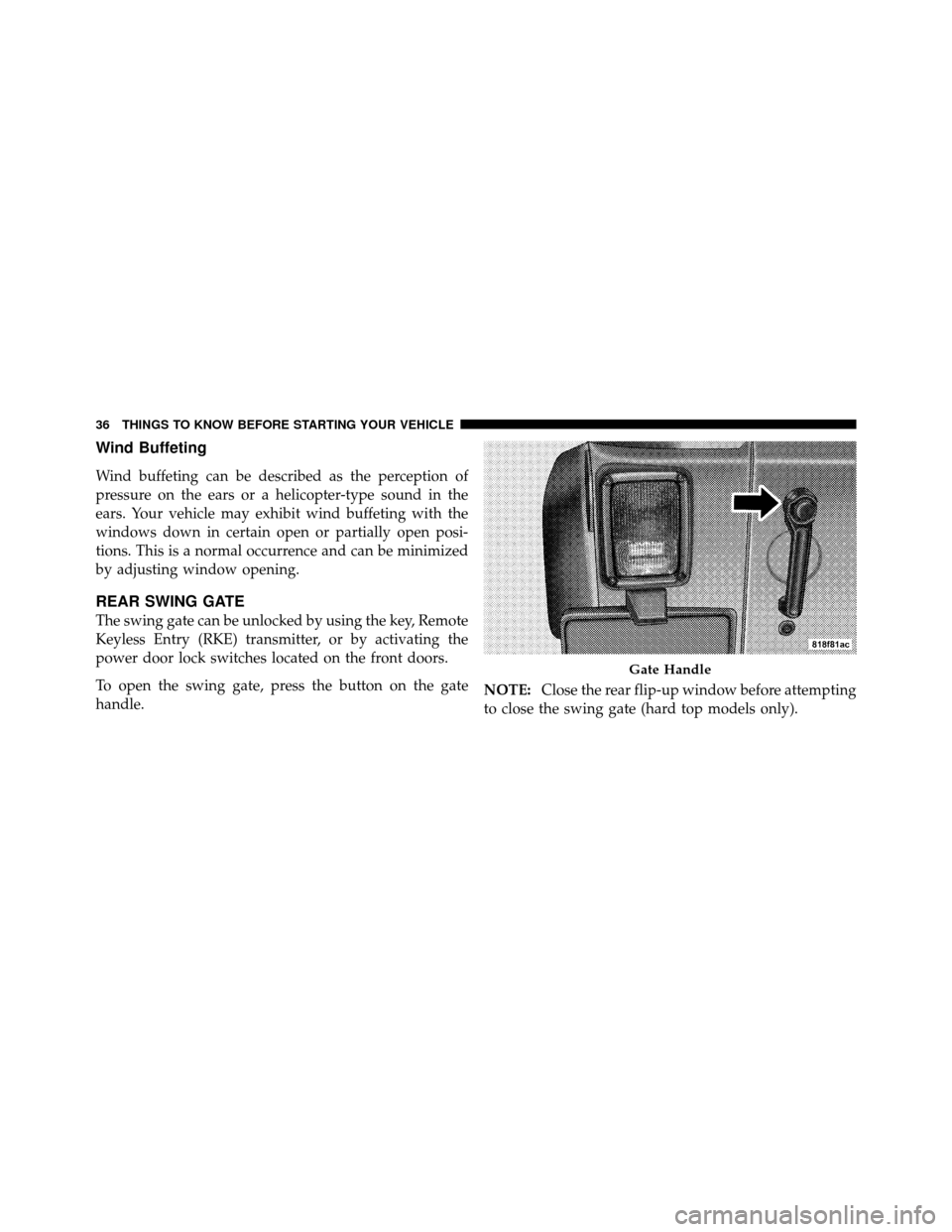
Wind Buffeting
Wind buffeting can be described as the perception of
pressure on the ears or a helicopter-type sound in the
ears. Your vehicle may exhibit wind buffeting with the
windows down in certain open or partially open posi-
tions. This is a normal occurrence and can be minimized
by adjusting window opening.
REAR SWING GATE
The swing gate can be unlocked by using the key, Remote
Keyless Entry (RKE) transmitter, or by activating the
power door lock switches located on the front doors.
To open the swing gate, press the button on the gate
handle.NOTE:
Close the rear flip-up window before attempting
to close the swing gate (hard top models only).
Gate Handle
36 THINGS TO KNOW BEFORE STARTING YOUR VEHICLE
Page 38 of 554
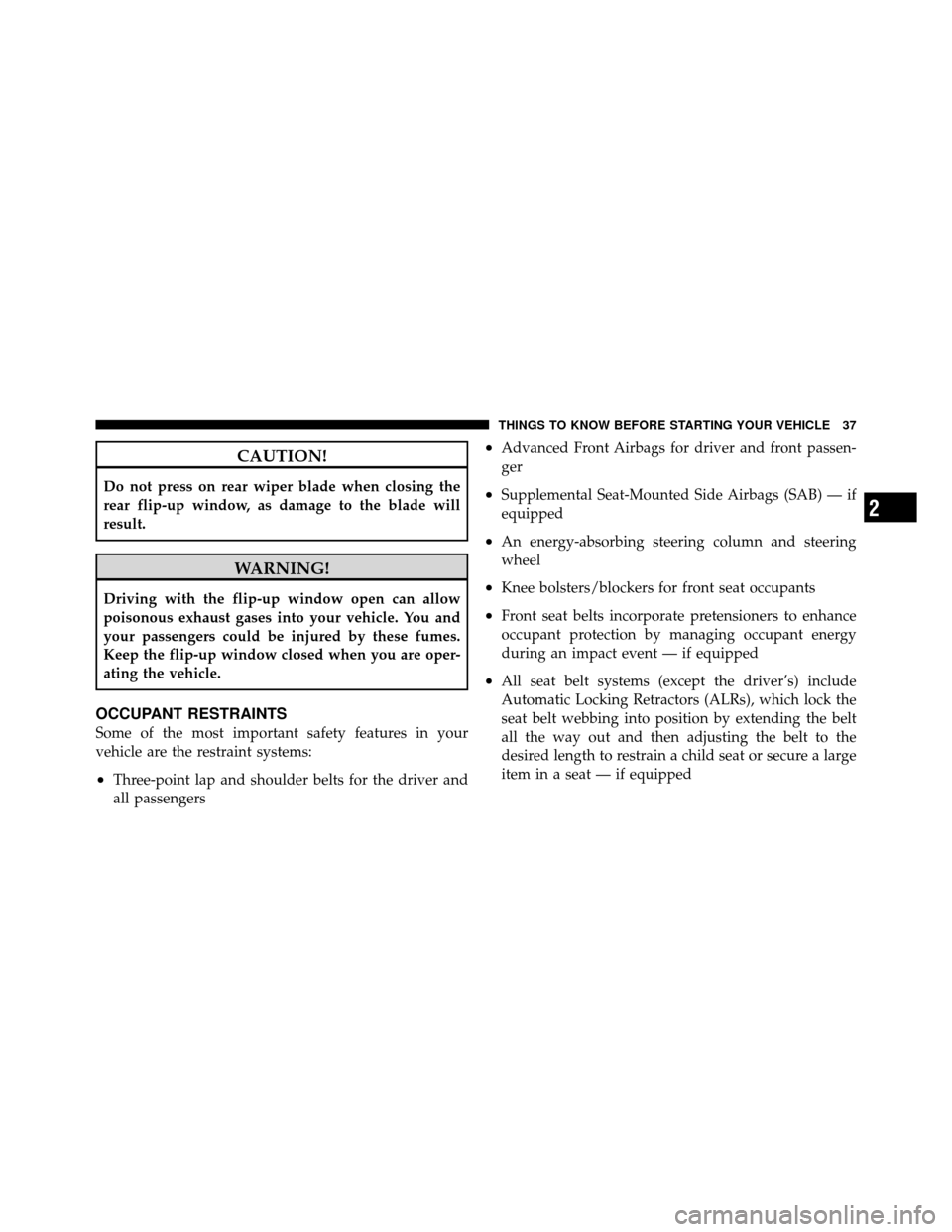
CAUTION!
Do not press on rear wiper blade when closing the
rear flip-up window, as damage to the blade will
result.
WARNING!
Driving with the flip-up window open can allow
poisonous exhaust gases into your vehicle. You and
your passengers could be injured by these fumes.
Keep the flip-up window closed when you are oper-
ating the vehicle.
OCCUPANT RESTRAINTS
Some of the most important safety features in your
vehicle are the restraint systems:
•Three-point lap and shoulder belts for the driver and
all passengers
•Advanced Front Airbags for driver and front passen-
ger
•Supplemental Seat-Mounted Side Airbags (SAB) — if
equipped
•An energy-absorbing steering column and steering
wheel
•Knee bolsters/blockers for front seat occupants
•Front seat belts incorporate pretensioners to enhance
occupant protection by managing occupant energy
during an impact event — if equipped
•All seat belt systems (except the driver’s) include
Automatic Locking Retractors (ALRs), which lock the
seat belt webbing into position by extending the belt
all the way out and then adjusting the belt to the
desired length to restrain a child seat or secure a large
item in a seat — if equipped
2
THINGS TO KNOW BEFORE STARTING YOUR VEHICLE 37
Page 39 of 554
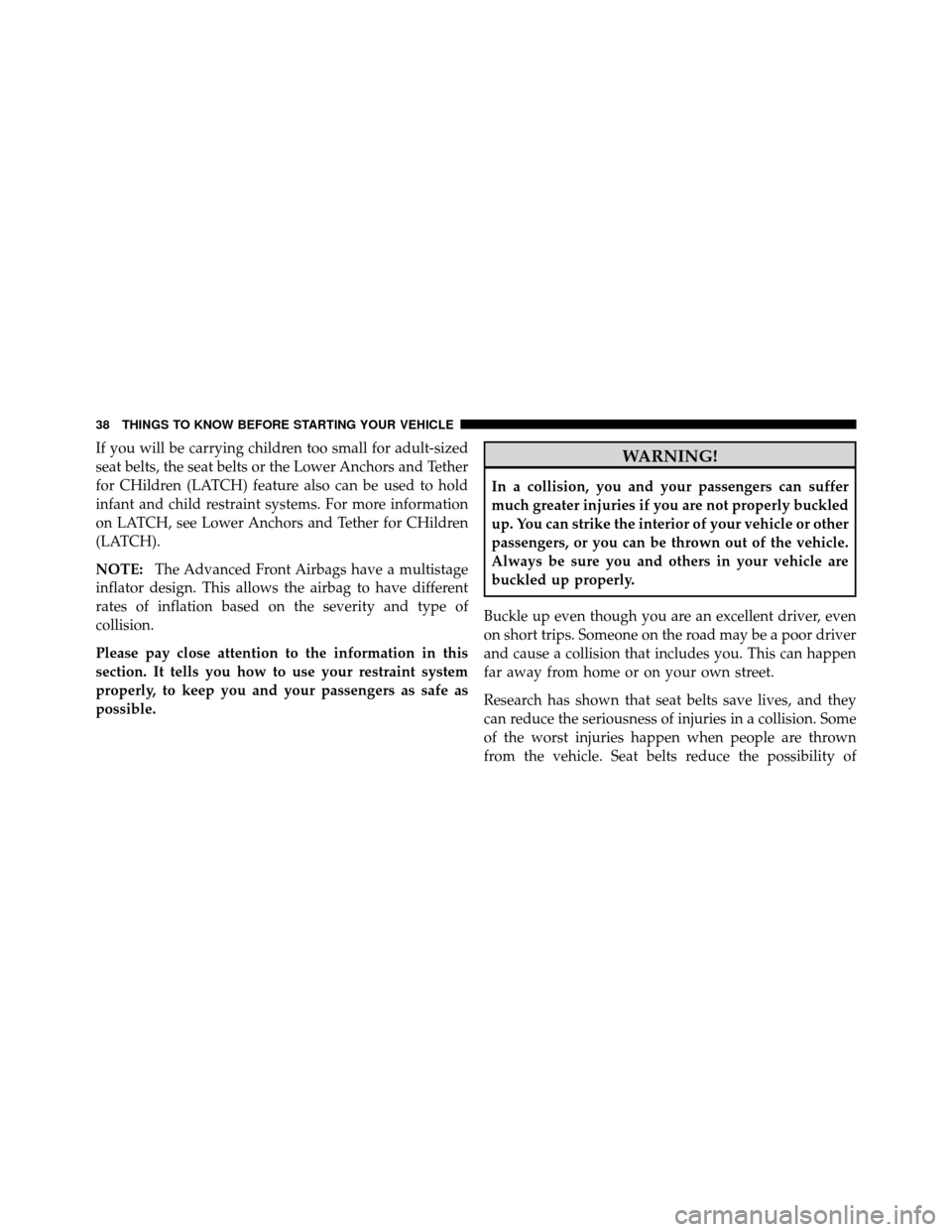
If you will be carrying children too small for adult-sized
seat belts, the seat belts or the Lower Anchors and Tether
for CHildren (LATCH) feature also can be used to hold
infant and child restraint systems. For more information
on LATCH, see Lower Anchors and Tether for CHildren
(LATCH).
NOTE:The Advanced Front Airbags have a multistage
inflator design. This allows the airbag to have different
rates of inflation based on the severity and type of
collision.
Please pay close attention to the information in this
section. It tells you how to use your restraint system
properly, to keep you and your passengers as safe as
possible.WARNING!
In a collision, you and your passengers can suffer
much greater injuries if you are not properly buckled
up. You can strike the interior of your vehicle or other
passengers, or you can be thrown out of the vehicle.
Always be sure you and others in your vehicle are
buckled up properly.
Buckle up even though you are an excellent driver, even
on short trips. Someone on the road may be a poor driver
and cause a collision that includes you. This can happen
far away from home or on your own street.
Research has shown that seat belts save lives, and they
can reduce the seriousness of injuries in a collision. Some
of the worst injuries happen when people are thrown
from the vehicle. Seat belts reduce the possibility of
38 THINGS TO KNOW BEFORE STARTING YOUR VEHICLE
Page 40 of 554
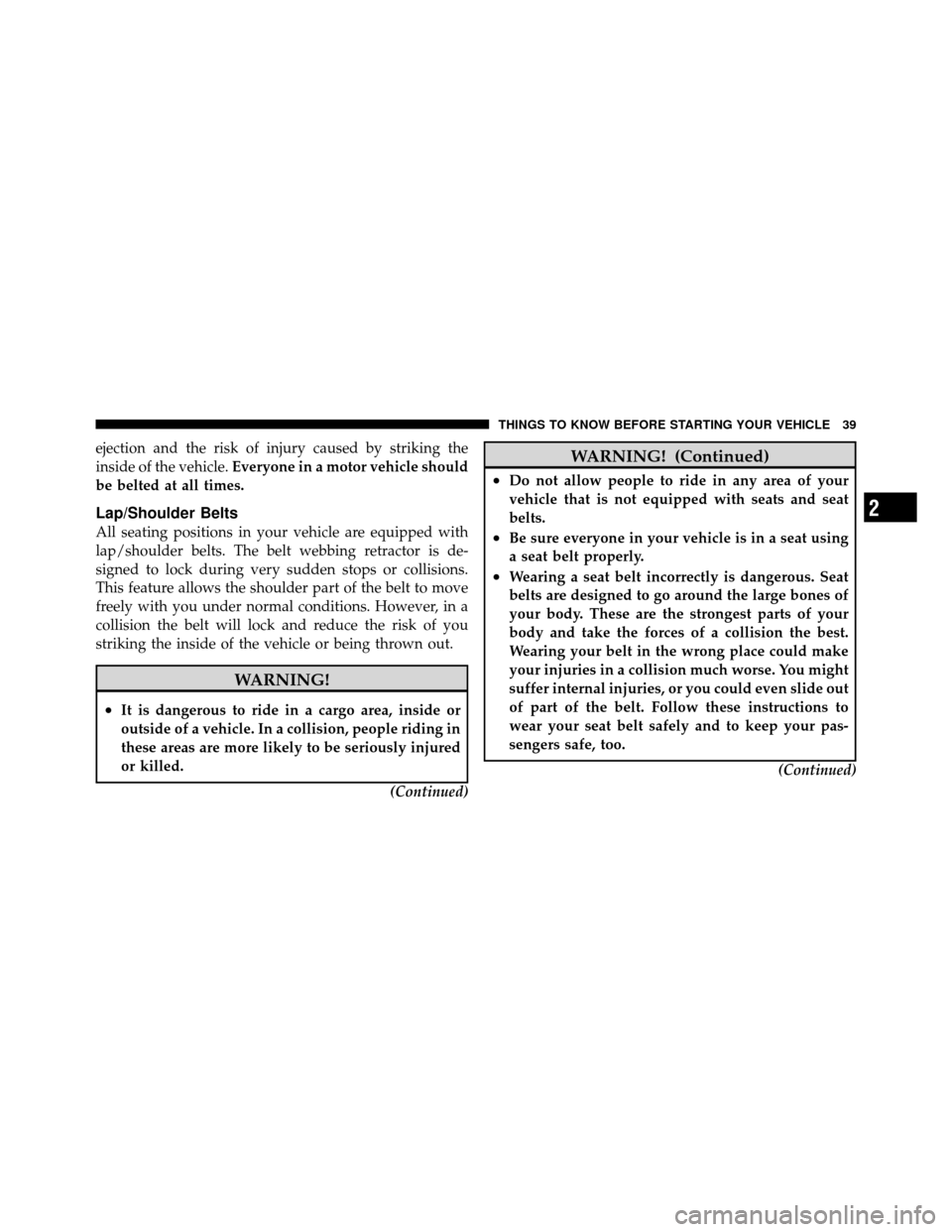
ejection and the risk of injury caused by striking the
inside of the vehicle.Everyone in a motor vehicle should
be belted at all times.
Lap/Shoulder Belts
All seating positions in your vehicle are equipped with
lap/shoulder belts. The belt webbing retractor is de-
signed to lock during very sudden stops or collisions.
This feature allows the shoulder part of the belt to move
freely with you under normal conditions. However, in a
collision the belt will lock and reduce the risk of you
striking the inside of the vehicle or being thrown out.
WARNING!
•It is dangerous to ride in a cargo area, inside or
outside of a vehicle. In a collision, people riding in
these areas are more likely to be seriously injured
or killed.
(Continued)
WARNING! (Continued)
•Do not allow people to ride in any area of your
vehicle that is not equipped with seats and seat
belts.
•Be sure everyone in your vehicle is in a seat using
a seat belt properly.
•Wearing a seat belt incorrectly is dangerous. Seat
belts are designed to go around the large bones of
your body. These are the strongest parts of your
body and take the forces of a collision the best.
Wearing your belt in the wrong place could make
your injuries in a collision much worse. You might
suffer internal injuries, or you could even slide out
of part of the belt. Follow these instructions to
wear your seat belt safely and to keep your pas-
sengers safe, too.(Continued)
2
THINGS TO KNOW BEFORE STARTING YOUR VEHICLE 39